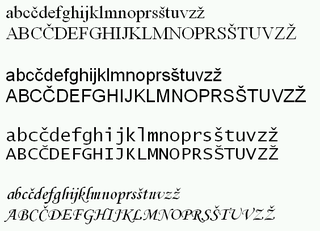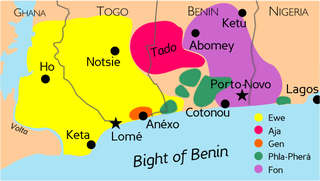A diacritic is a glyph added to a letter or to a basic glyph. The term derives from the Ancient Greek διακριτικός, from διακρίνω. The word diacritic is a noun, though it is sometimes used in an attributive sense, whereas diacritical is only an adjective. Some diacritics, such as the acute ( ◌́ ) and grave ( ◌̀ ), are often called accents. Diacritics may appear above or below a letter or in some other position such as within the letter or between two letters.

Hausa is a Chadic language spoken by the Hausa people in the northern half of Nigeria, Ghana, Cameroon, Benin and Togo, and the southern half of Niger, Chad and Sudan, with significant minorities in Ivory Coast.
A macron is a diacritical mark: it is a straight bar ¯ placed above a letter, usually a vowel. Its name derives from Ancient Greek μακρόν (makrón) "long", since it was originally used to mark long or heavy syllables in Greco-Roman metrics. It now more often marks a long vowel. In the International Phonetic Alphabet, the macron is used to indicate a mid-tone; the sign for a long vowel is instead a modified triangular colon ⟨ː⟩.
The acute accent, ◌́, is a diacritic used in many modern written languages with alphabets based on the Latin, Cyrillic, and Greek scripts. For the most commonly encountered uses of the accent in the Latin and Greek alphabets, precomposed characters are available.
The double acute accent is a diacritic mark of the Latin and Cyrillic scripts. It is used primarily in Hungarian or Chuvash, and consequently it is sometimes referred to by typographers as hungarumlaut. The signs formed with a regular umlaut are letters in their own right in the Hungarian alphabet—for instance, they are separate letters for the purpose of collation. Letters with the double acute, however, are considered variants of their equivalents with the umlaut, being thought of as having both an umlaut and an acute accent.
The circumflex is a diacritic in the Latin and Greek scripts that is also used in the written forms of many languages and in various romanization and transcription schemes. It received its English name from Latin: circumflexus "bent around"—a translation of the Greek: περισπωμένη.
A breve is the diacritic mark ˘, shaped like the bottom half of a circle. As used in Ancient Greek, it is also called brachy, βραχύ. It resembles the caron but is rounded, in contrast to the angular tip of the caron. In many forms of Latin, ˘ is used for a shorter, softer variant of a vowel, such as "Ĭ", where the sound is nearly identical to the English /i/.

The Slovene alphabet is an extension of the Latin script used to write Slovene. The standard language uses a Latin alphabet which is a slight modification of the Croatian Gaj's Latin alphabet, consisting of 25 lower- and upper-case letters:

Yoruba is a language spoken in West Africa, primarily in Southwestern and Central Nigeria. It is spoken by the ethnic Yoruba people. The number of Yoruba speakers is roughly 50 million, plus about 5 million second-language speakers. As a pluricentric language, it is primarily spoken in a dialectal area spanning Nigeria and Benin with smaller migrated communities in Côte d'Ivoire, Sierra Leone and The Gambia.

Fon is spoken in Benin, Nigeria, Togo, Ghana and Gabon by approximately 1.7 million speakers, and is the language of the Fon people. Like the other Gbe languages, Fon is an isolating language with an SVO basic word order.
The Dangbe language, also Dangbe or Adaŋgbi, is a Kwa language spoken in south-eastern Ghana by the Dangbe People (Dangbeli). The Dangbeli are part of the larger Ga-Dangbe ethnic group. Klogbi is a variant, spoken by the Kloli. Kropp Dakubu (1987) is the most thorough grammar of the language.
The grave accent is a diacritical mark used to varying degrees in French, Dutch, Portuguese, Italian and many other western European languages, as well as for a few unusual uses in English. It is also used in other languages using the Latin alphabet, such as Mohawk and Yoruba, and with non-Latin writing systems such as the Greek and Cyrillic alphabets and the Bopomofo or Zhuyin Fuhao semi-syllabary. It has no single meaning, but can indicate pitch, stress, or other features.
Tẹẹ, or Tai, is an Ogoni language and the language of the Tai tribe of the Ogoni people of Rivers State, Nigeria. It is to a limited degree mutually intelligible with Khana, the main Ogoni language, but its speakers consider it to be a separate language.
Ngbaka (Ngbàkà) is a Gbaya language spoken by just over a million people in the Democratic Republic of the Congo. It is a regionally important language, used by the Gilima, Ngbundu, Mbandja and Mono peoples, and is taught in primary schools; 10% are literate in Ngbaka.
Foodo is a Guang language spoken in and around the town of Sèmèrè in the north of Benin. There are approximately 37,000 speakers. A large proportion of the population live beyond the homeland in other parts of Benin, as well as in neighboring Togo, Nigeria, and Ghana. There may be as many as 1,000 living in Ghana.
Tem, or Kotokoli (Cotocoli), is a Gur language spoken in Togo, Ghana, Benin and Burkina Faso. It is used by neighboring peoples. In Ghana the Kotokoli people comes from a northern part of the Volta Region a town called Koue. Koue shares boarder with Togo with a small river which is called the Koue river separating it from Togo.
Nateni (Natemba) is a language of the Gurma people spoken in Benin. It is named after its principal dialect; the others are Tayari (Tayaba), Kunteni (Kuntemba), Okoni (Okoma).
Berba, also known as Biali, Bieri, Bjeri, Bjerbe or Bialaba, is a Gur language of Benin. There are also a thousand or so speakers in the Kompienga Province of Burkina Faso, where they are believed to have originated;in the Savanes Region of Togo, and in Kwara State in Nigeria.
Karenni or Red Karen, known in Burmese as Kayah, is a Karen dialect continuum spoken by over half a million Kayah people in Burma.






